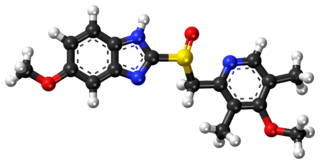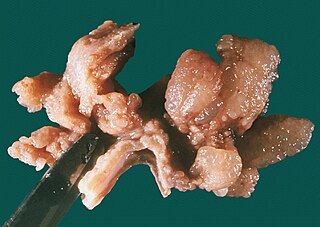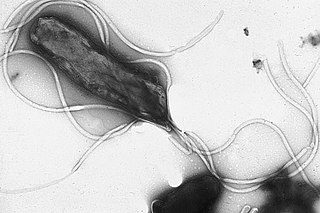| Chronic gastritis | |
|---|---|
 | |
| Mucosal layers of the stomach | |
| Specialty | Gastroenterology |
REDIRECT Gastritis Chronic gastritis is a chronic inflammation of the gastric mucosa, as opposed to Acute Gastritis where the symptoms occur for a relatively short time.
| Chronic gastritis | |
|---|---|
 | |
| Mucosal layers of the stomach | |
| Specialty | Gastroenterology |
REDIRECT Gastritis Chronic gastritis is a chronic inflammation of the gastric mucosa, as opposed to Acute Gastritis where the symptoms occur for a relatively short time.
Many people who have chronic gastritis do not experience any noticeable symptoms. Those who do, claim to experience one or several of the following: upper abdominal pain, indigestion, bloating, nausea, vomiting, belching, loss of appetite, and weight loss. Stomach bleeding or black stool has been reported in extreme cases.
Chronic gastritis is a progressive, life-long inflammation. It usually begins in childhood with superficial mononuclear inflammation and acute neutrophilic inflammation in the gastric antrum and fundus. It progresses to atrophic gastritis with loss of normal mucous glands. This results in the loss of iron, calcium, magnesium and zinc absorption. The loss of mucous glands resulted in the growth of immature glandular and epithelial cells resembling the glands in the small bowel or colon (intestinal metaplasia) which can cause gastric adenocarcinoma through intraepithelial neoplasia. [1]
H. pylori infection is the most common form of chronic gastritis. In the beginning, the involvement tends to occur in either an gastric antrum, then progressive spreading to the gastric fundus, where the whole gastric mucosa is involved or with the sparing of certain parts of gastric mucosa. This resulted in the progressive reduced secretion of gastric acid and finally absent gastric acid secretion. The H.pylori infection may fade off in the absence of gastric acid secretion but gastric adenocarcinoma may gradually kick in. The yearly risk of progressing from one step to the next is 2 to 3%. [1]
Since 1992, chronic gastritis lesions are classified according to the Sydney system. [2]
Several factors are accounted for in diagnosing chronic gastritis. Diagnosis can be based upon: medical history, physical exam, upper GI endoscopy and other tests. During the medical history, a health practitioner will ask the patient about the symptoms experienced and the duration of the symptoms, as well as travels to certain foreign countries. A physical exam may include listening to the patient's stomach. Upper GI endoscopy test is administered by inserting a camera through the patient's mouth and it checks for evidence of bleeding and inflammation in the stomach. Other tests include: a blood test, a stool sample, a urea breath tes t, or an x-ray.
Medications to lessen the acid production of the stomach and to treat the causes of chronic gastritis are prescribed. Excessive acid production weakens the stomach lining. Medications to reduce the effects of acid production on the stomach lining include: antacids, H2 Blockers, and proton pump inhibitors (PPIs). [3]

Peptic ulcer disease (PUD) is a break in the inner lining of the stomach, the first part of the small intestine, or sometimes the lower esophagus. An ulcer in the stomach is called a gastric ulcer, while one in the first part of the intestines is a duodenal ulcer. The most common symptoms of a duodenal ulcer are waking at night with upper abdominal pain and upper abdominal pain that improves with eating. With a gastric ulcer, the pain may worsen with eating. The pain is often described as a burning or dull ache. Other symptoms include belching, vomiting, weight loss, or poor appetite. About a third of older people have no symptoms. Complications may include bleeding, perforation, and blockage of the stomach. Bleeding occurs in as many as 15% of cases.

Helicobacter pylori, previously known as Campylobacter pylori, is a Gram-negative, microaerophilic bacterium usually found in the stomach. It was identified in 1982 by Australian doctors Barry Marshall and Robin Warren, who found that it was present in a person with chronic gastritis and gastric ulcers, conditions not previously believed to have a microbial cause. It is also linked to the development of duodenal ulcers and stomach cancer. However, over 80% of individuals infected with the bacterium are asymptomatic, and it may play an important role in the natural stomach ecology.

Helicobacter is a genus of Gram-negative bacteria possessing a characteristic helical shape. They were initially considered to be members of the genus Campylobacter, but in 1989, Goodwin et al. published sufficient reasons to justify the new genus name Helicobacter. The genus Helicobacter contains about 35 species.

Barry James Marshall is an Australian physician, Nobel Prize Laureate in Physiology or Medicine, and Professor of Clinical Microbiology at the University of Western Australia. Marshall and Robin Warren showed that the bacterium Helicobacter pylori plays a major role in causing many peptic ulcers, challenging decades of medical doctrine holding that ulcers were caused primarily by stress, spicy foods, and too much acid. This discovery has allowed for a breakthrough in understanding a causative link between Helicobacter pylori infection and stomach cancer.
Coffee ground vomitus refers to a particular appearance of vomit. Within organic heme molecules of red blood cells is the element iron, which oxidizes following exposure to gastric acid. This reaction causes the vomitus to look like ground coffee. Coffee ground vomitus is a sign of possible upper gastrointestinal bleeding.

Esomeprazole, sold under the brand names Nexium among others, is a medication which reduces stomach acid. It is used to treat gastroesophageal reflux disease, peptic ulcer disease, and Zollinger–Ellison syndrome. Effectiveness is similar to other proton pump inhibitors (PPIs). It is taken by mouth or injection into a vein.

Achlorhydria, also known as hypochlorhydria, refers to states where the production of hydrochloric acid in gastric secretions of the stomach and other digestive organs is absent or low, respectively. It is associated with various other medical problems.

Gastrointestinal diseases refer to diseases involving the gastrointestinal tract, namely the oesophagus, stomach, small intestine, large intestine and rectum, and the accessory organs of digestion, the liver, gallbladder, and pancreas.
Indigestion, also known as dyspepsia, is a condition of impaired digestion. Symptoms may include upper abdominal fullness, heartburn, nausea, belching, or upper abdominal pain. People may also experience feeling full earlier than expected when eating. Dyspepsia is a common problem and is frequently caused by gastroesophageal reflux disease (GERD) or gastritis. In a small minority of cases it may be the first symptom of peptic ulcer disease and, occasionally, cancer. Hence, unexplained newly onset dyspepsia in people over 55 or the presence of other alarming symptoms may require further investigations.

Atrophic gastritis is a process of chronic inflammation of the gastric mucosa of the stomach, leading to a loss of gastric glandular cells and their eventual replacement by intestinal and fibrous tissues. As a result, the stomach's secretion of essential substances such as hydrochloric acid, pepsin, and intrinsic factor is impaired, leading to digestive problems. The most common are vitamin B12 deficiency which results in a megaloblastic anemia and malabsorption of iron, leading to iron deficiency anaemia. It can be caused by persistent infection with Helicobacter pylori, or can be autoimmune in origin. Those with the autoimmune version of atrophic gastritis are statistically more likely to develop gastric carcinoma, Hashimoto's thyroiditis, and achlorhydria.

Ménétrier disease is a rare, acquired, premalignant disease of the stomach characterized by massive gastric folds, excessive mucous production with resultant protein loss, and little or no acid production. The disorder is associated with excessive secretion of transforming growth factor alpha (TGF-α). It is named after a French physician Pierre Eugène Ménétrier, 1859–1935.

This is a timeline of the events relating to the discovery that peptic ulcer disease and some cancers are caused by H. pylori. In 2005, Barry Marshall and Robin Warren were awarded the Nobel Prize in Physiology or Medicine for their discovery that peptic ulcer disease (PUD) was primarily caused by Helicobacter pylori, a bacterium with affinity for acidic environments, such as the stomach. As a result, PUD that is associated with H. pylori is currently treated with antibiotics used to eradicate the infection. For decades prior to their discovery, it was widely believed that PUD was caused by excess acid in the stomach. During this time, acid control was the primary method of treatment for PUD, to only partial success. Among other effects, it is now known that acid suppression alters the stomach milieu to make it less amenable to H. pylori infection.

Duodenitis is inflammation of the duodenum. It may persist acutely or chronically.

The abdominopelvic cavity is a body cavity that consists of the abdominal cavity and the pelvic cavity. It contains the stomach, liver, pancreas, spleen, gallbladder, kidneys, and most of the small and large intestines. It also contains the urinary bladder and internal reproductive organs. The abdominal pelvic cavity is a little pocket sac that lies way low in the base of the abdominal pelvis cavity. There's no membrane that separates out the abdominal cavity from the pelvic cavity so it is sometimes referred to as the abdominal pelvis or the peritoneal cavity. There are many diseases and disorders associated with the organs of the abdominopelvic cavity.

Stomach diseases include gastritis, gastroparesis, diarrhea, Crohn's disease and various cancers.
Lafutidine (INN) is a second generation histamine H2 receptor antagonist having multimodal mechanism of action and used to treat gastrointestinal disorders. It is marketed in Japan and India.

Troxipide is a drug used in the treatment of gastroesophageal reflux disease. Troxipide is a systemic non-antisecretory gastric cytoprotective agent with anti-ulcer, anti-inflammatory and mucus secreting properties irrespective of pH of stomach or duodenum. Troxipide is currently marketed in Japan (Aplace), China (Shuqi), South Korea (Defensa), and India (Troxip). It is used for the management of gastric ulcers, and amelioration of gastric mucosal lesions in acute gastritis and acute exacerbation of chronic gastritis.

The gastric folds are coiled sections of tissue that exist in the mucosal and submucosal layers of the stomach. They provide elasticity by allowing the stomach to expand when a bolus enters it; these folds stretch outward through the action of mechanoreceptors which respond to the increase in pressure. This allows the stomach to expand, therefore increasing the volume of the stomach without increasing pressure. These folds provide the stomach with increased surface area for nutrient absorption during digestion. Gastric folds may be seen during esophagogastroduodenoscopy or in radiological studies.
Helicobacter heilmannii sensu lato refers to a group of bacteria species within the Helicobacter genus. The Helicobacter genus consists of at least 40 species of spiral-shaped flagellated, Gram-negative bacteria of which the by far most prominent and well-known species is Helicobacter pylori. H. pylori is associated with the development of gastrointestinal tract diseases such as stomach inflammation, stomach ulcers, doudenal ulcers, stomach cancers that are not lymphomas, and various subtypes of extranodal marginal zone lymphomass, e.g. those of the stomach, small intestines, large intestines, and rectumn. H. pylori has also been associated with the development of bile duct cancer and has been associated with a wide range of other diseases although its role in the development of many of these other diseases requires further study.
| Classification | |
|---|---|
| External resources |